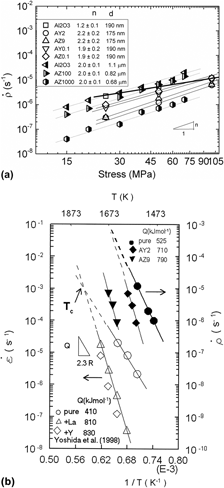Article contents
Influence of yttria and zirconia additions on spark plasma sintering of alumina composites
Published online by Cambridge University Press: 30 March 2015
Abstract

The mechanisms of densification and creep were examined during spark plasma sintering (SPS) of alumina doped with a low and high level of zirconia or yttria, over a temperature range of 1173–1573 K and stresses between 25 and 100 MPa. Large additions of yttria led clearly to in situ reactions during SPS and the formation of a yttrium-aluminum garnet phase. Dopants generally lead to a reduction in the densification rate, with substantial reductions noted in samples with ∼5.5 vol% second phase. In contrast to a stress exponent of n ∼ 1 for pure alumina, the doped aluminas displayed n ∼ 2 corresponding to an interface-controlled diffusion process. The higher activation energies in the composites are consistent with previous data on creep and changes in the interfacial energies. The results reveal a compensation effect, such that an increase in the activation energy is accompanied by a corresponding increase in the pre-exponential term for diffusion.
- Type
- Articles
- Information
- Copyright
- Copyright © Materials Research Society 2015
References
REFERENCES
- 2
- Cited by


